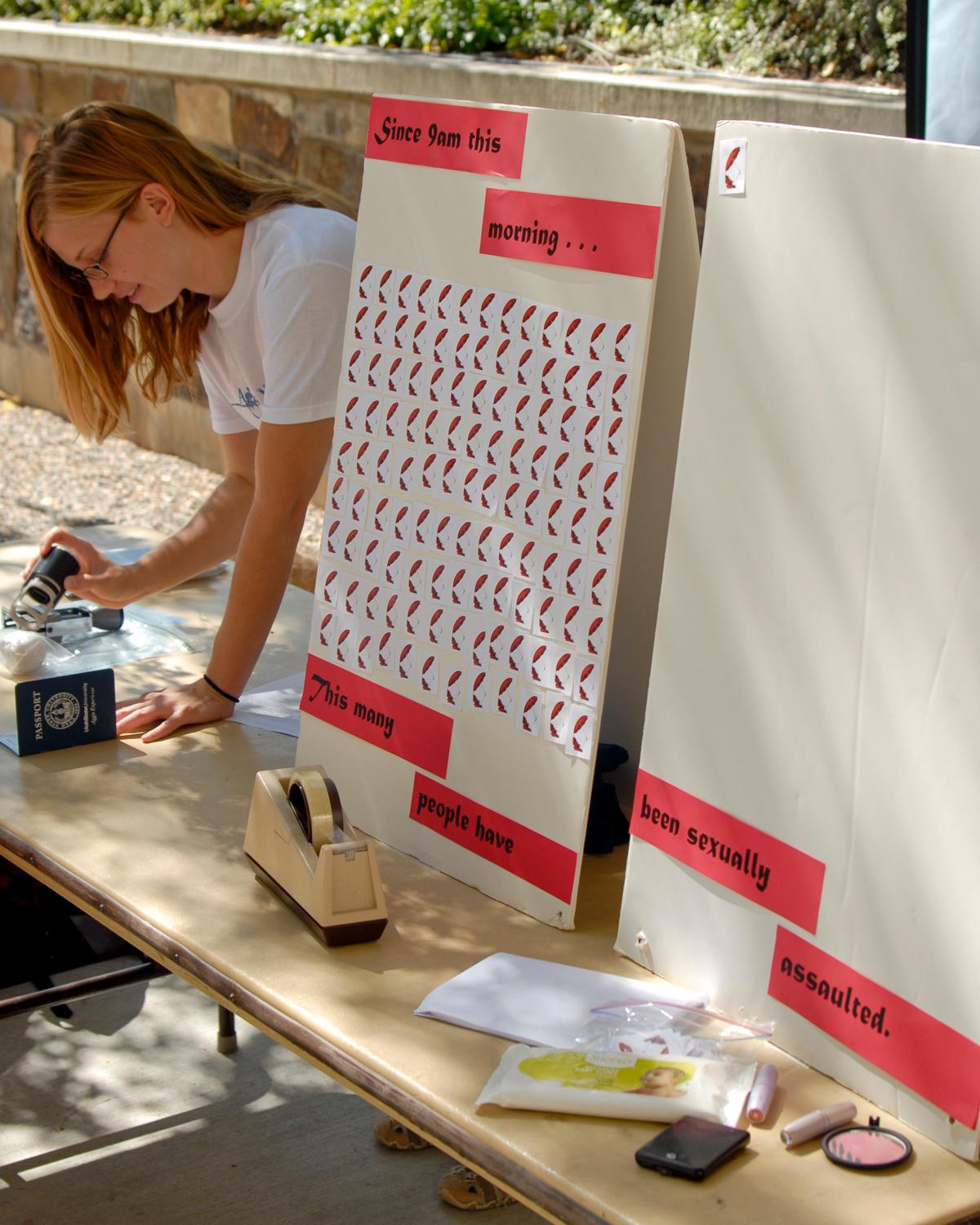Domestic abuse victim shares her difficult past
The Sexual Assault and Anti-Violence Information (SAAVI) Office campaigned Thursday on the TSC Patio, with a unique presentation by a domestic violence survivor, as part of RAINN Day, an annual campaign to raise awareness of sexual violence on college campuses sponsored by the Rape, Abuse & Incest National Network.
“To those who are abused, both men and women, there is hope. You are worth it,” said Rachel, a social work and art major, who has asked that her last name remain anonymous.
Looking bulky in layers of clothing while standing on the patio, Rachel shed each layer throughout the course of her speech: a rainbow-striped jacket, then a black and red high-collared blouse, then finally to an Aggie Game Day shirt, as she read a monologue about her abusive 11-year marriage and journey toward recovery.
Rachel said she was a victim of mental, emotional and eventually physical abuse by her ex-husband.
“I wish there had been one person who came to me in the whole 11 years and said, ‘You’re important, you don’t have to be treated this way,’ or ‘There’s other options,'” Rachel said. “And there wasn’t anybody. So, if there’s a woman out here stuck in that, and they hear it from me, I would love to hear that.”
Passing students stopped to listen as she spoke, and by the end the crowd grew to 20 silent students and volunteers.
Heather Frost, a freshman deaf education major, said Rachel’s story hit close to home. She recently left her husband of five years, because he was a perpetrator of domestic abuse, she said.
Frost said, “It lets me know that even though you go through hard stuff, you can come through it.”
This isn’t the first time Rachel has done her presentation for a group, she said. Though she had to pause two or three times, she never cried. She said she has gotten better at keeping her composure throughout the presentation.
“It’s just kind of my way of trying to heal and trying reach people,” she said.
Rachel said how her now-ex-husband made her wear bright red lipstick at all times, let her wear only dark colored clothes — mostly black and red — insulted her daily and only allowed her to leave the house to go to work. In the last month before she left him, Rachel said, he raped her.
“After, as I was crying, he said that I was his,” she said. “And as long as I was his, I would do my job.”
Saying she was going to visit her mother who lived five hours away, and against threats of unnamed consequences from her husband if she did so, Rachel said she fled her home with her three young sons, in 2004.
“I ran for the car and left as fast as I could,” she said. “I didn’t drive freeways, so I drove about 40 miles per hour all the way to her house. It took me nine hours. I am really surprised the police didn’t stop me.”
Rachel and her children went underground and lived in women’s shelters as she worked out what to do, she said. Finally, she went back to Seattle, where she’d left her husband, to get a restraining order from a judge. The judge was the first person to give her confidence, she said.
“I walked in there with my head down. The first thing he said to me was ‘Look up, look in my eyes,'” she said. “And it was kind of like he was treating me like an equal, and that had never happened to me before. He said, ‘I’m not going to ask you one single question. You deserve to be safe.'”
The judge, who had read her official statement, instructed Rachel to go upstairs in the courthouse and file the documents. She now has a lifelong restraining order against her ex-husband, she said.
Rachel uses the layers of clothing to signify her experiences. The multi-colored, striped jacket represents her happy personality before meeting her ex-husband. When talking about her marriage, she took it off to reveal the black and red jacket, colors she wore the most because her he made her wear them.
“I don’t wear black and red anymore,” she said, explaining the jacket came from a local thrift store.
She smiled for the first time when she took off the black and red jacket and wiped off the red lipstick her husband made her wear, almost constantly, during their marriage.
“This is my favorite part,” she said.
Rachel said she came to SAAVI when she moved to Logan to attend USU, last year. She said she was so nervous she thought she was going to have a heart attack.
“But then I got settled in, and I was like, ‘Okay, I can try this,'” she said.
Needing to volunteer for a social work class, Rachel said SAAVI was the natural choice. SAAVI Coordinator Monica Bailey asked her to tell her story for RAINN Day, which is geared toward teaching college students about sexual violence and the resources available for victims.
Bailey said this is the first time RAINN Day has come to USU.
“I was looking for something new that the students would be able to connect with,” Bailey said.
In addition to Rachel telling her story several times during the day, SAAVI set up a banner that students could trace their hands on and sign to pledge against sexual violence. Once they signed the banner, they pulled a candy from poster boards that spelled the word “rape” with the candies. Bailey said pulling the candies off is symbolic.
“They can ‘eliminate’ rape,” Bailey said.
– la.stewart@aggiemail.usu.edu

Erin Henrie, a junior majoring in family consumer and human development, stamps Aggie passports and answers questions after a student addressed a group about domestic abuse on the TSC Patio, Thursday. According to the chart beside her, 118 people were sexually assulted, hypothetically, between 9 a.m. and 1

